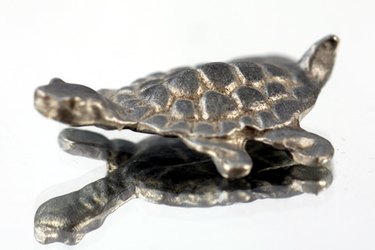Things You'll Need
Protective gloves
Face shield
Metal ladle
Blowtorch
Molds
Wire cutters

According to blacksmith Darrell Markewitz from the Wareham Forge in Ontario, pewter is one of the easier metals to work with thanks to its low melting point and relative fluidity. Pewter will melt and flow when exposed to nearly any heat source, including a simple cooking fire or a stove. This convenience and ease of use makes pewter a popular material for home-based model makers ready to cast their own figures.
Step 1
Wear protective, heat-resistant gloves and a full face shield when working with pewter.
Video of the Day
Step 2
Hold your pewter pieces in a metal ladle. Using a hand-held blowtorch and run the flame over the pewter surface. The pewter will not begin to run until the whole block is melted. Continue until all the pewter has melted.
Step 3
Put down the torch and firmly grasp your mold. Quickly pour your melted pewter into the hole at the top of the mold. Wait until the pewter solidifies. Depending on your type of mold, this can take up to 10 minutes. Watch the "button," the small pewter circle formed at the entrance to the mold. When this has solidified, so has the rest of the mold.
Step 4
Open the mold and gently remove the pewter. Cut the button off of the mold. It can be remelted for use on other projects.
Tip
Pewter will form in many types of mold including iron, brass, plaster of Paris and stone. Complex designs may require for the mold to be preheated so that the pewter does not solidify while you are still pouring.
Warning
All materials, including the ladle and molds, must be completely dry before melting and casting pewter. Any water can cause a violent reaction in the pewter, sending hot metal spraying out.
Video of the Day